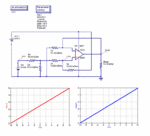jlewis184
Newbie level 3
I'm designing a microcontroller application for controlling LEDs. The application is battery powered and the micro is running at +5V.
I need help on conditioning an input signal to the A/D of the micro. The input is a control voltage (CV) from Eurorack synthesizer module, and swings +/- 10V. I want to offset and scale this 20Vpp signal to 0 to 5V, for sampling with the micro.
Can someone explain how to do this with a single, 5V positive supply? I think I need a rail-to-rail opamp, with virtual GND at 2.5V, and use a voltage divider to scale the input....but I'm not too clear on the details.
Thanks,
Josh
I need help on conditioning an input signal to the A/D of the micro. The input is a control voltage (CV) from Eurorack synthesizer module, and swings +/- 10V. I want to offset and scale this 20Vpp signal to 0 to 5V, for sampling with the micro.
Can someone explain how to do this with a single, 5V positive supply? I think I need a rail-to-rail opamp, with virtual GND at 2.5V, and use a voltage divider to scale the input....but I'm not too clear on the details.
Thanks,
Josh

